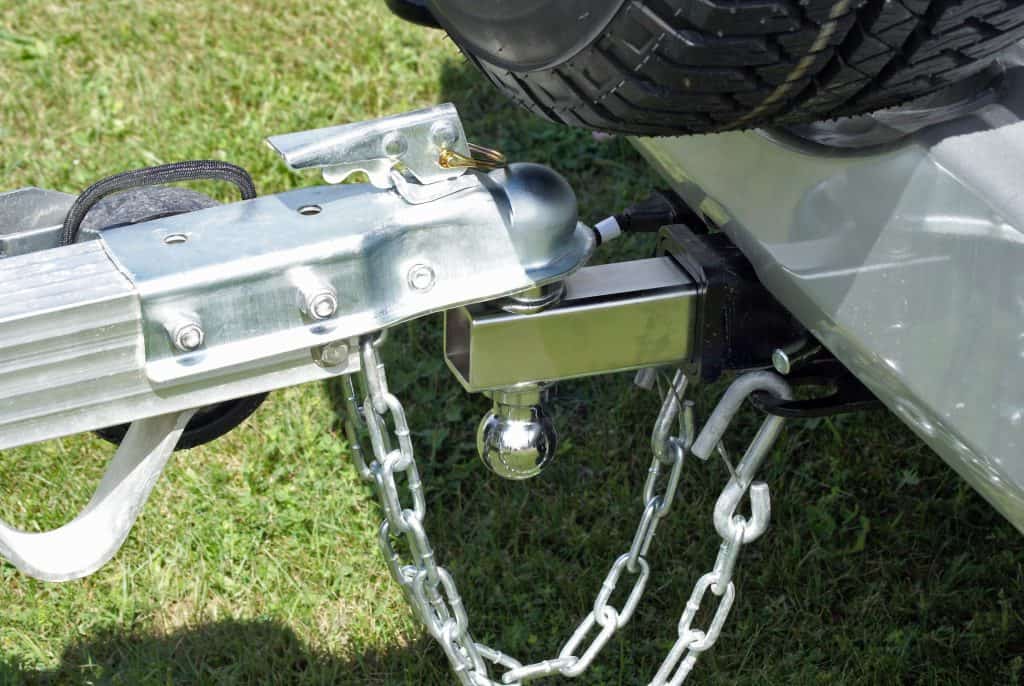
Whether you’re a first-time buyer considering your different RV options, or a previous owner of a travel trailer or fifth wheel, you might be wondering what the differences are between these two types of vehicles.
Both fifth wheels and travel trailers are popular choices for people who like to live comfortably on the road, but they each come with their own unique challenges and requirements.
One area in which they differ is their hitches and the way that they attach to their respective towing vehicles.
Fifth wheels require a fifth wheel hitch, which is installed in the bed of a truck. These are easier to connect to than a travel trailer hitch, but are bulkier and initially harder to install. Travel trailers only take an extra moment to connect, but sometimes require more configuring if a weight-distributing hitch is needed.
There are pros and cons to the setup process of both travel trailers and fifth wheels. Travel trailer hitches are more versatile and have a lot of safety features built in, while fifth wheel hitches are easy to connect to once they’re installed and can be used to pull a greater amount of weight.
Hooking up a Fifth Wheel
The first step to look at when you’re hooking up a fifth wheel is getting a properly installed hitch. Fifth wheels need specialized hitches that must be properly installed in the bed of the trucks. No other vehicle can pull a fifth wheel due to their overhanging design, need for swiveling hitches, and heavyweight. Likewise, fifth wheel hitches won’t connect with any other type of trailer.
It’s right there in the name folks! Fifth wheel hitches are for fifth wheels only.
Fifth wheel hitches need to be properly installed in a truck bed to prevent damage to the truck or the fifth wheel. The first thing that must be embedded into the truck bed is two long metal rods, which form the base of the hitch.
These run parallel to the long sides of the truck bed. Their midpoints should usually rest above the main axle. This is the strongest part of the truck, and so it can support the greatest amount of weight.
These rods are usually then drilled into the bed of the truck through holes along their length and are secured in place with special screws, washers, spacers, and brackets. This support system from both inside and outside the bed is important to keep the thin metal beneath the truck bed from crumbling under the weight and strain of hauling a heavy fifth wheel.
Fifth wheel hitches need to be installed properly to make sure that all your equipment, as well as your truck and fellow drivers on the road, stay safe. It’s usually best to get it installed by a professional due to the individual challenges and specifications of each individual truck. Fuel lines, internal wiring, and construction quirks vary from one truck to the next.
But if you’re confident in your mechanic abilities and have the proper equipment, it’s possible to install a hitch yourself. This video gives an excellent guide to installing a fifth wheel hitch, as well as an explanation for why everything it set up the way that it is.
Once your hitch is properly installed and ready to go, the next thing to do is to connect your fifth wheel. You connect the fifth wheel to a truck by backing the truck into alignment with the hitch. Before you actually back your truck up though, there are a few things you should do to make it safer and easier.
Correctly Using and Connecting to a Fifth Wheel Hitch
First, make sure that your fifth wheel is stable by placing chocks behind the wheels. This will prevent it from shifting or rolling if it’s jostled during the connection process. Second, make sure that the pin of your fifth wheel is at the proper height to fit into the hitch. Measure the distance between the two and make any necessary adjustments to the pin height of the fifth wheel.
After that, all you need to do is make sure that your hitch is in the open position to connect and slowly back the truck into position. It’s usually best if you have someone on the outside to guide you through this part. The fifth wheel pin should slide into the hitch comfortably and the jaws should close.
Park your truck and then you can move on to the final steps of connection.
Double check that the hitch is securely fastened around the fifth wheel pin, then rotate the safety lever and attach the pin to keep it from coming loose. At this stage, you also need to make sure that your emergency breakaway system is hooked up as well. This will stop your trailer from moving if it becomes detached from your truck during travel.
Finally, you just need to hook up your brake lights and turn signal cables to the fifth wheel, raise the tailgate if it was lowered, and retract the legs of your fifth wheel, placing its full weight onto the truck. Check to make sure that your lights all work and that nothing is scraping along the road. You’re then clear to remove the wheel chocks and be on your way!
So although it can be tricky to install a fifth wheel hitch in the first place, attaching your fifth wheel to the truck doesn’t really take long at all. Once everything is set up, you just back up, lock the hitch in place and place the weight on the truck.
All in all, only the beginning of this setup is tough.
Pros and Cons to Fifth Wheel Hitches
As with anything in life, fifth wheels have their own mix of benefits and drawbacks. In some ways, they’re easier to connect to than travel trailers, but they also come with their own unique challenges.
Pros:
- There’s a pretty simple connection process
- Some hitches can swivel, which can increase the turning capacity of the connected truck
- Hitches can carry a massive amount of weight
- The hitches stay in the truck bed after their first installation (aka, no removal and reinstallation necessary)
Cons:
- Hitches only work with trucks that can pull the extra heavy load of a fifth wheel, which is generally more than a travel trailer of equal length
- Hitches are large, heavy, and cumbersome to remove from a truck bed
- Hitches take up a large part of the truck bed
- Hitches can initially be difficult and expensive to install
- The large amount of weight can wear on a truck’s structural integrity over time
As an overall recap, fifth wheel hitches are generally simpler than travel trailer to connect to. They require less equipment, take fewer steps to attach and use a hitch that doesn’t require additional setup once it’s installed.
However, the hitch itself can take up a lot of space and limit the attachments that your truck can pull in the future. The hitch also takes a lot of work to install in the first place.
Hooking up a Travel Trailer
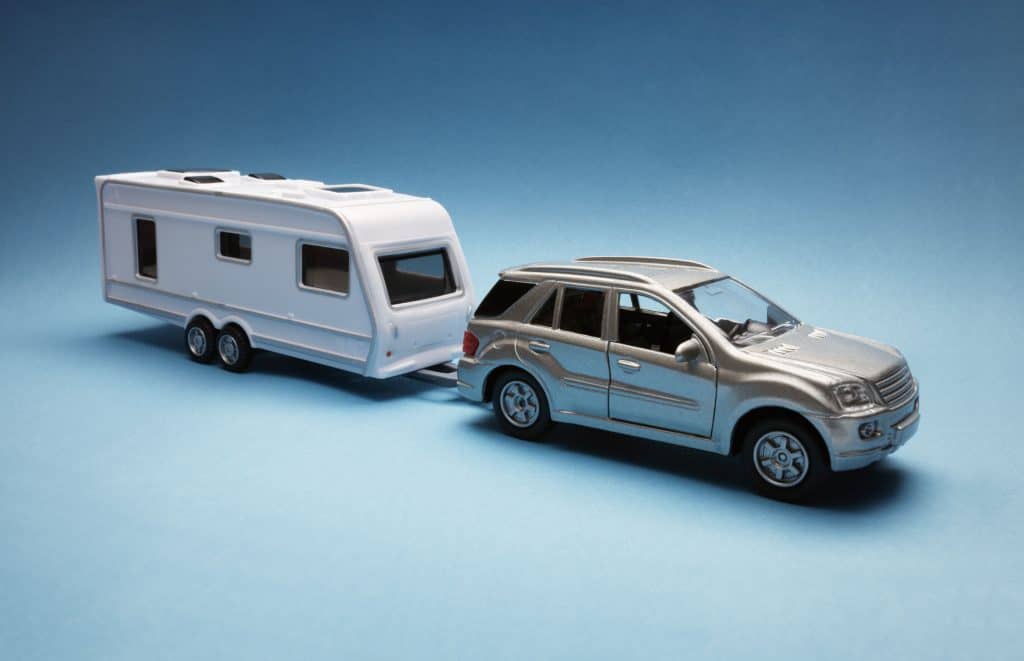
Connecting a travel trailer to the tow vehicle is a bit more of a process than a fifth wheel. Travel trailers are still quite heavy, but not as heavy as fifth wheels. Because they fall in this middle range, they can be pulled by cars other than trucks, but they must usually be connected using a weight distribution hitch.
Weight distribution hitches go beyond the basic ball and pin hitch that many vehicles offer on their bumpers. They involve a series of safety chains, spring rods, and pins, as well as the standard ball and pin connector.
These hitches spread out the weight of the trailer throughout the tow vehicle so that not all the strain is put onto the back end. If you try to pull a heavy travel trailer with just a standard ball and pin hitch, your car might tip back on its back wheels while the trailer falls forward.
This creates a tricky situation for everyone and it’s definitely not something that you want to deal with! So, to properly attach a travel trailer to your car, you’ll need to follow this process.
Correctly Using and Connecting to a Weight Distribution Hitch:
To begin, you’ll want to line up your car with the trailer. Make sure that everything is aligned for when it’s time to back up. Place wheel chocks behind the wheels of the travel trailer to prevent any shifting or sliding. Then use the trailer jack to raise the tongue of the trailer. Make it high enough that the ball of the hitch can slide underneath the tongue without touching or scraping against each other.
Next, slowly back up your car. Use another person as a spotter if possible. You don’t want to scratch your paint or create a dent with a sloppy backing up job! Next, you need to open up the coupler latch on the trailer and use the crank to lower the tongue over the ball hitch. Lower it until they fit securely together.
Close the coupler latch and insert the hitch pin to prevent it from coming loose.
The next thing you want to connect is the spring bars, which help to distribute the weight of the trailer. To start this process, use the trailer hitch to raise the tongue of the trailer a couple of inches. Take one of the spring bars and attach one end to the corresponding opening on the vehicle hitch. Swing the bar out until it aligns with the brackets along the edge of the travel trailer.
Lower each of the brackets and loop one link of the spring bar chain over the hook. Do this with both sets of springs bars, one on each side of the trailer. Once everything is hooked up, you can fold the hinges up and lock them into place using safety clips.
Once the spring bars and ball hitch are attached, you can retract the tongue jack to place the weight onto the tow vehicle. You’ll also want to retract the tongue jack to prevent any scraping against the road once you’re driving.
Next up, you’ll want to attach the safety chains. These provide additional connection and strength between the vehicles. Attach them to permanent pieces of the tow vehicle so that they don’t jostle loose or rip anything fragile off.
The safety chains can either be attached in a crossed X pattern or attached parallel to each other between the vehicle and trailer. Make sure that you leave enough loose sway in the chains to permit sharp turns, but keep them tight enough to avoid any dragging or scraping.
The last safety feature to add is the breakaway cable. Again, attach this to a solid piece of the tow vehicle so that it doesn’t jostle loose prematurely. The cable must also be attached to a battery in the trailer to ensure that it has the power to do its job of deploying emergency brakes.
Finally, you just need to connect the cable to enable the brake lights and turn signals on your travel trailer. Make sure that all the lights work, double check for any loose pieces and dragging equipment, remove your wheel chocks, and you’re good to go!
Now I know that was a lot of steps to keep track of. That shouldn’t discourage you from trying out a travel trailer though!
If you’d like a video guide to help you through this process, this one does a great job at explaining how to perform each step, as well as illustrate what each piece of equipment looks like.
Attaching a travel trailer hitch requires a longer process with more steps than a fifth wheel. There’s more room for error with this setup, but it works well. The hitch is designed to spread the weight evenly throughout the car and has a variety of safety features built into it.
Pros and Cons to Weight Distribution Hitches
Travel trailers take a bit more time and effort to attach than fifth wheels do. But they also come with their own distinct advantages. Check out this list of compared pros and cons below to judge whether or not this setup is right for you.
Pros:
- These hitches can be used for any attachment that has a ball and tongue system
- Hitches can be attached to a variety of cars, not just trucks
- Weight is evenly spread to prevent tipping and improve steering control
- There are a variety of safety features
Cons:
- These hitches can’t support as much weight as fifth wheel hitches do
- Fairly complicated connection process
- Lots of equipment and pieces required for proper setup (these can be lost or broken)
- Still quite heavy and difficult to maneuver in tight spaces
So as an overall recap of travel trailer hookups, it generally takes more work each time you want to connect and detach your trailer from the tow vehicle. There are more steps and little pieces of equipment needed.
But on the other hand, your vehicle doesn’t permanently have a bulky hitch attached like fifth wheels do. This setup can also be used for lots of different cars and attachments, making it much more flexible and adaptable.

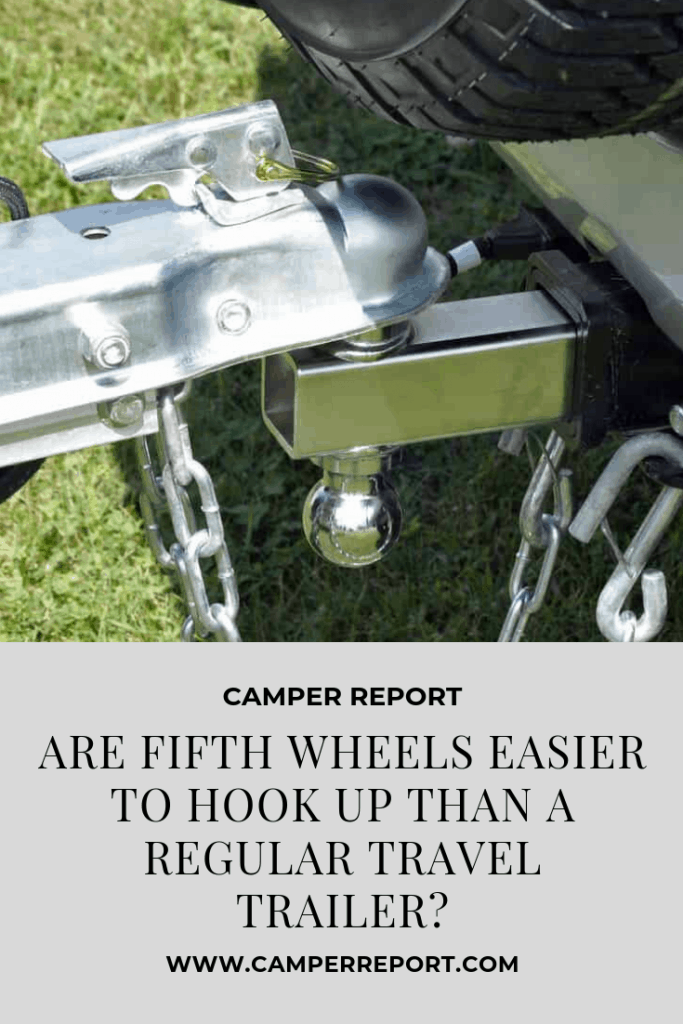
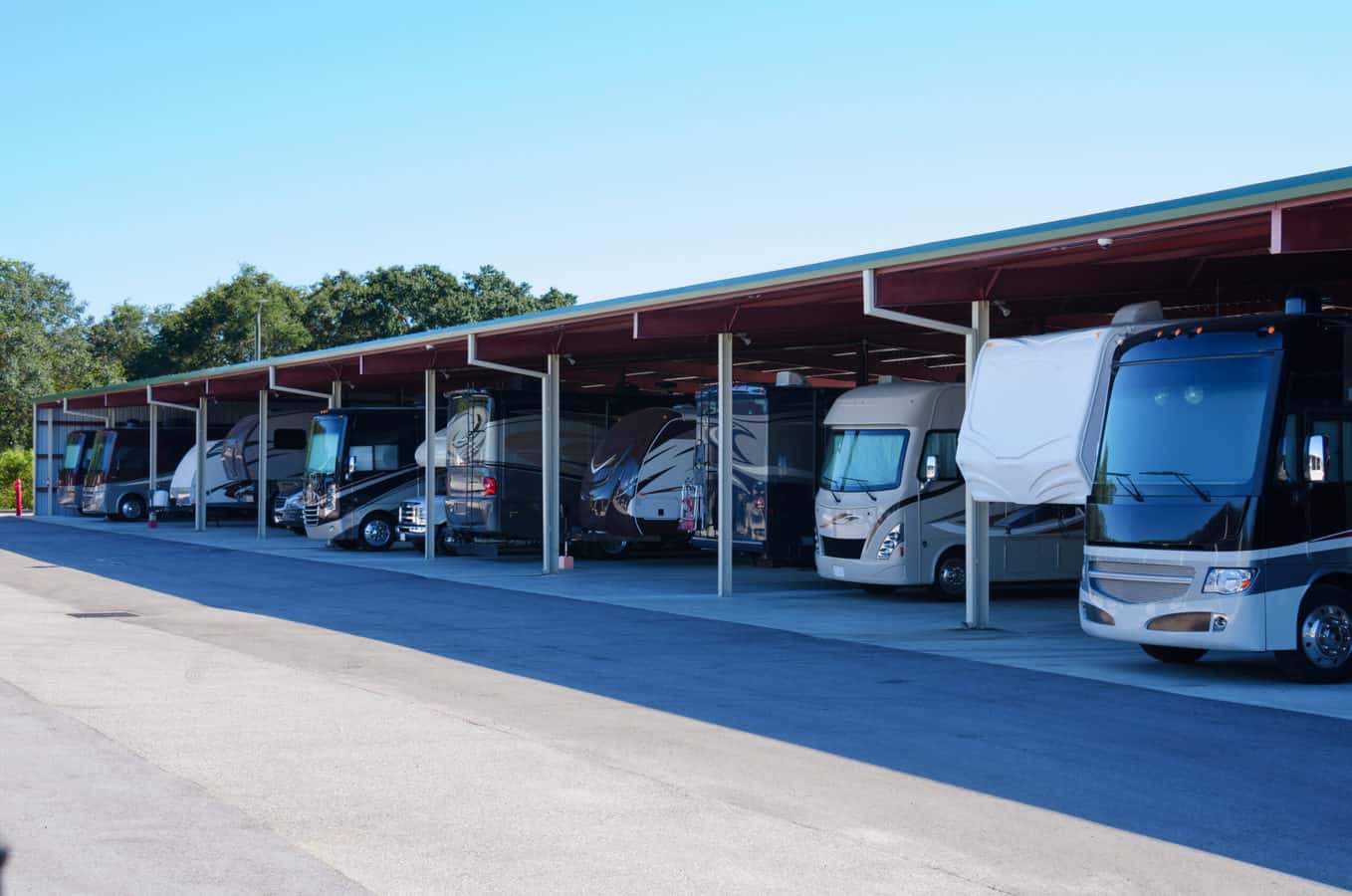
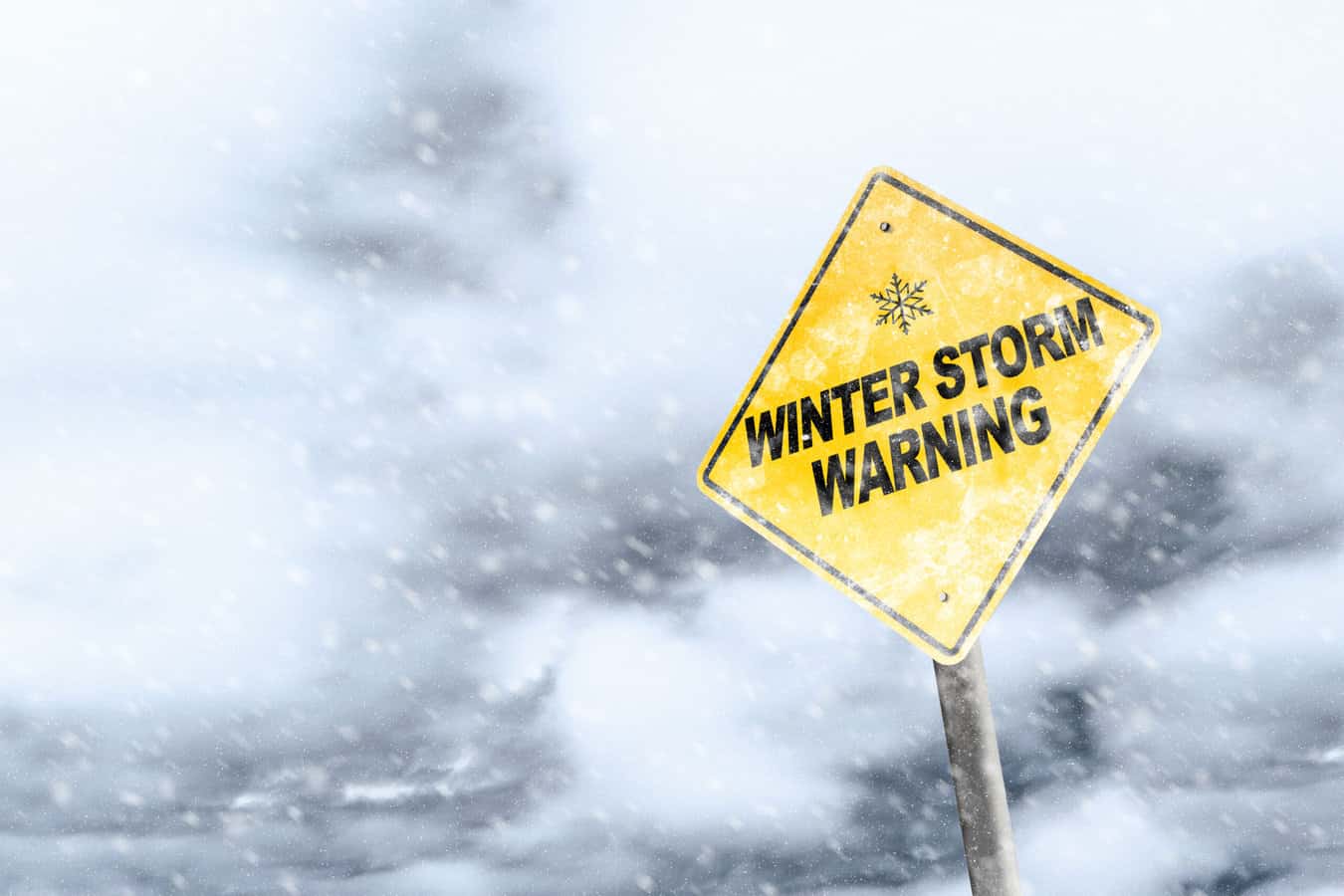

The technical complexity of using a weight distributing hitch creates a learning curve. It is also useful to understand how to set it up properly, so that minor adjustments can be made with heavier or lighter trailer loads. However, this should not prevent you from using one. I think the more important consideration is physical strength. Hitching up a 5th wheel doesn’t involve lifting. However, weight distributing torsion bars and other hardware are made of steel and are heavy, and there is physical effort involved in hitching and unhitching.
I suggest that if you are physically active and maintain your strength through exercise, and you have no trouble lifting 25 or 30 lbs, you should find the WDH manageable. If you have physical limitations, a 5th wheel may be a better choice.
I was just wondering if, as a single lady traveling alone, a 5th wheel would be a better choice as far as set up and using a rig? It is what I am now leaning toward as a live-aboard after retirement.
I’m a single woman, I fulltimed for 15 years in an Airstream trailer…….. If I were stationary I would choose a fifth wheel, but since I went all over the Airstream was better.
Sandy I have owned most types of RV’s as well put many miles on them. I’ve towed millions of miles pulling various types of trailers from RV’s to flat beds and box trailers even 18 wheelers. The two you are considering travel trailer and fifth wheel both have advantages and disadvantages. I will start with the fifth wheel.
If you do not have a truck now do yourself a favor and order it with the towing package and the fifth wheel prep regardless of what type of trailer you settle on.
So the biggest advantage of a quality fifth wheel RV is handling. They handle the imperfect road conditions including wind for superior than any travel trailer I have ever pulled. Generally speaking they have more interior room and more dry storage than a conventional travel trailer. Once you hitch is installed in the bed of your truck they are easier to hook up to but we are talking maybe a few minutes to an experienced person. Just a piece of advise if you go with a fifth wheel do not use the rail system mentioned above, the rails always remain in your truck bed in the way for a smooth bed floor. That is old school technology. Your two best options are the factory puck system, thus is also available aftermarket and the B&W Turnover Ball setup with their fifth wheel companion hitch. I personally like the puck system best, Reece makes a good one but either are good setups. The down side of a fifth wheel is they cut corners off more when turning and takes a learning curve and in some instances can be harder to back into some situations plus they are typically taller in overall height than a travel trailer.
As for as travel trailers go they typically are a little lower to the ground so egress is a bit easier, there is nothing in the truck bed so if you need to hall something while towing you can. A fifth wheel hitch is cumbersome and heavy to lift out of the bed if you want to use your truck as a truck when not towing. A travel trailer dies take a few minutes to connect to but it is very easy to remove the hitch from the receiver if you don’t want it hanging out back for whatever reason.
If you have toys to take along a fifth wheel can be had as a toy hauler but thus usually increases length. They have these available in travel trailers as well but not something I would recommend. Besides if your toys aren’t to big you can haul them in the bed of the truck with a travel trailer.
It is kind of a preference of what you want to tow, your needs, and how much you want to spend. For me given a choice I would probably get a toy hauler fifth wheel. If you don’t have toys I would opt for the convenience of a nice fifth wheel. Regardless I like to tell everyone this, floor plan is what makes you happy and handling is what makes you comfortable on the road. The rest is all options. Speaking of options in some fifth wheels you can option for a washer and dryer if you will be living in it or have extended trips.